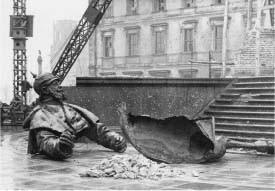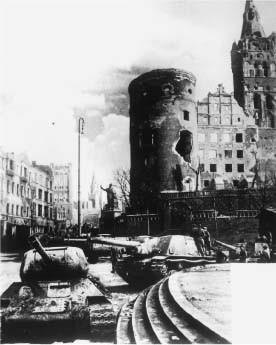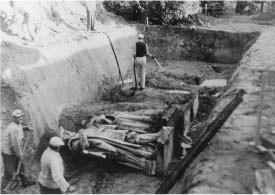Iron Kingdom : The Rise and Downfall of Prussia, 1600-1947 (116 page)
Read Iron Kingdom : The Rise and Downfall of Prussia, 1600-1947 Online
Authors: Christopher Clark

The American and French delegations broadly supported this view; only the Soviets dragged their feet, mainly because Stalin still hoped to use Prussia as the hub of a unified Germany over which the Soviet Union might eventually be able to secure control. But by early February 1947, they too had fallen into step and the way was open for the legal termination of the Prussian state.
In the meanwhile, the extirpation of Prussia as a social milieu was already well advanced. The Central Committee of the German Communist Party in the Soviet zone of occupation announced in August 1945 that the ‘feudal estate-owners and the Junker caste’ had always been ‘the bearers of militarism and chauvinism’ (a formulation that would find its way into the text of Law No. 46 of the Allied Control Council). The removal of their ‘socio-economic power’ was thus the first and fundamental precondition for the ‘extirpation of Prussian militarism’. There followed a wave of expropriations. No account was taken of the
political orientation of the owners, or of their role in resistance activity. Among those whose estates were confiscated was Ulrich-Wilhelm Count Schwerin von Schwanenfeld, who had been executed on 21 August 1944 for his role in the July conspiracy.
146
These transformations took place against the background of the greatest wave of migrations in the history of German settlement in Europe. During the last months of the war, millions of Prussians fled westwards from the eastern provinces to escape the advancing Red Army. Of those who remained, some committed suicide, others were killed or died of starvation, cold or illness. Germans were expelled from East Prussia, West Prussia, eastern Pomerania and Silesia, and hundreds of thousands perished in the process. The emigrations and resettlements continued into the 1950s and 1960s. The looting or burning of the great East-Elbian houses signalled the end not only of a socio-economic elite but also of a distinctive culture and way of life. Finckenstein, with its Napoleonic memorabilia, Beynuhnen with its collection of antiques, Waldburg with its rococo library, Blumberg and Gross Wohnsdorff with their memories of the liberal ministers von Schön and von Schroetter were among the many country seats to be plundered and gutted by an enemy bent on erasing every last trace of German settlement.
147
So it was that the Prussians, or at least their mid-twentieth-century descendants, came to pay a heavy price for the war of extermination that Hitler’s Germany unleashed on Eastern Europe.
The scouring of Prussia from the collective awareness of the German population began before the end of the war with a massive aerial attack on the city of Potsdam. As a heritage site with little strategic or industrial significance, Potsdam was very low on the list of Allied targets and had been spared significant bombardment during the war. Late in the evening of Saturday 14 April 1945, however, 491 planes of British Bomber Command dropped their payloads over the city, transforming it into a sea of fire. Almost half the historical buildings of the old centre were obliterated in a bombing that lasted for only half an hour. When the fires had been extinguished and the smoke had cleared, the scorched 57-metre tower of the Garrison Church stood as the dominant landmark in a cityscape of ruins. Of the fabled carillon, famous for its automated renditions of the ‘Leuthen Chorale’, there remained only a lump of metal. The scouring continued after 1945, as entire districts of the old city were cleared to make way for socialist reconstruction. The
imperatives of post-war city planning were reinforced by the anti-Prussian iconoclasm of the Communist authorities.
148

60. East Berlin, 1950: five years after the end of the Second World War, the upper torso and head of a fallen statue of Kaiser William I rest near a chunk of his horse
Nowhere was the rupture with the past more comprehensive than in East Prussia. The north-eastern part of the province, including Königsberg, fell to Soviet Russia as war booty. On 4 July 1946, the city was renamed Kaliningrad, after one of Stalin’s most faithful henchmen, and the sovietized district around it became the Kaliningradskaya oblast. The city had been bitterly fought over during the last months of the war and during the early post-war years it remained a lunar landscape of ruins. ‘What a city!’ one Soviet Russian visitor declared in 1951. ‘The tram leads us through the humped, narrow streets of erstwhile Königsberg. “Erstwhile” because Königsberg truly is an erstwhile city. It doesn’t exist. For kilometres in every direction, an unforgettable landscape of ruins. The old Königsberg is a dead city.’
149
Most of the historical buildings in the old centre were stripped and torn down in an attempt to erase memories of its history. In some streets, only the Latin letters inscribed on the steel manhole covers of the city’s late-nineteenth-century sewerage system survived to remind the passerby of an older history.
Around the devastation, a new Soviet city took shape, monotonous and provincial, cut off from the world by a military exclusion zone.

61. The capture of Königsberg by Soviet troops, 1945
In the western zones of occupation too, the work of erasure proceeded apace. French policy-makers and commentators spoke in the early postwar years of the need for wholesale ‘
déprussification
’.
150
The bronze relief panels on the base of the Victory Column, raised in 1873 in celebration of the triumphs of Prussian arms over the Danes, the Austrians and the French in the Wars of German Unification, were removed
by the French occupation authorities and shipped to Paris. They were handed back to Berlin only on the occasion of the city’s 750 thanniversary celebrations in 1986. An even more emblematic fate awaited the colossal figures representing historic rulers from the House of Hohenzollern that had once lined the Siegesallee. These objects – bombastic masses of carved white stone – were transferred by the Nazi authorities to the Grosse Sternallee, one of the axes of the future Reich capital planned by Albert Speer, Hitler’s Chief Inspector of Buildings. Here they spent the war draped in camouflage netting. In 1947, they were torn down on the orders of the Allied Control Council in Berlin. In 1954 they were secretly buried in the sandy soil of Brandenburg, almost as if this were necessary to prevent the Germans from re-grouping for battle around their ancestral Prussian totems.
151

62. Workers bury the statues of Hohenzollern ancestors in the Bellevue Palace gardens, 1954
These impulses were carried over into the sphere of Allied re-education policy in the occupied zones. Here, the objective was to eliminate Prussia as a ‘mental construct’, to ‘deprussianize’ the German imagination. What exactly this would mean in practice was never agreed among the Allies or concretely defined by any of the zonal administrations, but the idea was influential none the less. Prussia was de-emphasized in the
teaching of German history. In the French zone in particular, traditional textbooks charting a teleological nationalist narrative culminating in the formation of the Bismarckian Empire of 1871 made way for narratives focused on Germany’s pre-national history and its manifold ties with the rest of Europe (especially France). The chronicle of battles and diplomacy that was the staple of the old Prussocentric history made way for the study of regions and cultures. Where references to Prussia were unavoidable, they were given a markedly negative spin. In the new textbooks of the French zone, Prussia figured as a voracious, reactionary power that had thwarted the beneficent effects of the French Revolution and destroyed the roots of enlightenment and democracy in Germany. Bismarck in particular emerged from this process of re-orientation with his reputation in ruins.
152
Frederick the Great, too, retreated from his privileged position in public memory, despite the best efforts of the conservative historian Gerhard Ritter to rehabilitate him as an enlightened ruler.
153
Allied policies were successful precisely because they harmonized with homegrown German (especially Catholic Rhenish and South German) traditions of antipathy to Prussia.
These endeavours were reinforced, moreover, by the global geopolitical imperatives that governed German politics after the establishment of two separate states in 1949. The German Federal and the German Democratic Republics now lay on either side of the Iron Curtain that divided the capitalist and Communist worlds. While Konrad Adenauer, the first Chancellor of the Federal Republic, pursued a policy of unconditional commitment to the West, the Communist eastern neighbour became a political dependency of Moscow, a ‘homunculus from the Soviet test-tube’. Under the pressure of this partition, which came to seem a permanent feature of the post-war world, the Prussian past retreated to the horizons of public memory. Berlin meanwhile, islanded deep within the eastern republic, acquired a new and charismatic identity. In 1949, when the Soviets blocked supplies to the western-occupied zones of the city, the Allies broke the siege with a massive airlift. Across the western world there was a surge of solidarity with the beleaguered outpost. It was a crucial first step towards the rehabilitation of western Germany as a member of the international community. The city’s prominence was further heightened by the erection of the Berlin Wall in August 1961, a spectacular monument to the polarities of the Cold War. In the 1960s and 1970s, West Berlin evolved into a showcase of western
liberty and consumerism, a vibrant walled enclave of neon go-go bars, high culture and political ferment. It no longer belonged to Prussia, nor even to Germany, but to the western world – a condition memorably encapsulated in President John F. Kennedy’s declaration during a visit to the city on 26 June 1963 that he, too, was ‘ein Berliner’.
In a sparkling essay of 1894, the celebrated Prussian novelist Theodor Fontane, then an elderly man, recalled the occasion of his first literary composition. The reminiscence took him back six decades to the year 1833, when he had been a fourteen-year-old schoolboy lodging with an uncle in Berlin. It was a warm Sunday afternoon in August. Fontane decided to put off his school homework, a German composition ‘on a self-chosen theme’, and visit family friends in the village of Löwenbruch, some five kilometres to the south of Berlin. By three in the afternoon he had reached the Halle Gate on the city boundary. From there the road led south across the broad Teltow plateau through Kreuzberg and Tempelhof to Grossbeeren. As he reached the outskirts of Grossbeeren, Fontane sat down at the foot of a poplar tree to rest. It was nearly evening and wisps of mist hung over the newly ploughed fields. Further down the road he could make out the raised ground of the Grossbeeren cemetery and the village church tower glowing in the rays of the sinking sun.
As he sat watching this peaceful scene, Fontane fell to pondering on the events that had transpired in this very spot almost exactly twenty years before, at the height of the wars against Napoleon. It was here that General Bülow with his Prussians, most of them men of the Landwehr, had attacked the French and Saxon forces under General Oudinot, denying them access to Berlin and turning the tide of the 1813 summer campaign. Fontane had only a sketchy schoolboy knowledge of the battle, but what he remembered was enough to embellish the landscape before him with vibrant
tableaux vivants
from the past. Urged by his commanding officer to retreat behind the capital city and await the French advance, Bülow had refused, saying that ‘he would rather see the bones of his militiamen whiten before than behind Berlin’. To the right of where Fontane was sitting was a low hill where a windmill turned; it was here that the Prince of Hessen-Homburg, ‘like his ancestor
before him at Fehrbellin’, had led a few battalions of Havelland militiamen against the French positions. Even more vivid than all of this was a story his mother had often retold from his earliest childhood, a ‘small event’ that had passed into family lore. Emilie Labry (later Fontane) was a daughter of the Francophone Huguenot colony in Berlin. On 24 August 1813, at the age of fifteen, she was among the women and girls who came out from the city to tend to the wounded still lying in the field on the morrow of the battle. The first man she happened upon was a mortally wounded Frenchman with ‘scarcely a breath left in his body’. Hearing himself addressed in his native language, he sat up ‘as if transfigured’, grasping her beaker of wine in one hand and her wrist with the other. But before he could raise the wine to his lips, he was dead. As he lay that night under his blankets in Löwenbruch, Fontane knew that he had found his theme. The topic of his school composition would be the battle of Grossbeeren.
154